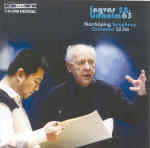Swedish composer Ingvar Lidholm took a trip to the Darmstadt summer school in 1949, and the rest, as they say, is history. These works from the composer’s “middle period” (1958-63) retain much of the apparent influence of the Continental avant-garde of the time, with ample comparisons to everyone from Ligeti to Lutoslawski. The music is neither “difficult” by modern standards nor particularly original, but it intrigues nonetheless in the masterly, creative ways Lidholm manipulates the orchestra and explores its myriad timbral possibilities. It should be mentioned upfront that this disc might have been a candidate for the marginalia bin were it not for BIS’ stunning, reference-quality sound and the splendid playing of the Norrköping Symphony Orchestra. In fact, this is one of the few instances when the recording actually makes a case for the music, which itself relies for its success on the ability to re-create huge dynamic contrasts, ear-shattering bass, and accurate instrumental rendering.
Of all the works on this disc, Mutanza seems to possess the most structure, recalling the Praeludium of Berg’s Three Pieces for Orchestra. Starting quietly and discretely in the cymbals, it swells and “mutates” inexorably into a massive percussion-fueled climax and ebbs into a hushed tam-tam tremor. The creepy Notturno probes calmer waters with allusions to Bartók in the strings/harp/timpani complement and in the frequent whirling timpani glissandos. While this part of the work also is subject to strident orchestral lunges, it makes for an apt prelude to the nihilist poetry of the Canto, which of course is about death. Motus-Colores is yet another experiment in the use of enormous orchestral forces, but after Mutanza it feels long, as if the point was already made perfectly well.
The final work, Riter (or Rites), represents Lidholm’s homage to Stravinsky’s Rite of Spring. How anyone danced to this ballet is beyond me, but the real fun is trying to locate all the references, inverted, bent, and twisted though they may be. Still, Riter possesses all the wild, crazed percussion, orgiastic orchestral spasms, and insistent, pounding rhythms of the more famous Rite. In the Intermezzo, however, things just get weird with the sudden introduction of some freakish tape music–ostensibly, an amorphous synthesized amalgam of goat and sheep calls combined with yodeling that nonetheless sounds like a bunch of humpback whales being tortured. Normality slowly resumes in the arid opening of the Procession. The two sacrificial dances that follow are oddly contemplative at the outset, but really begin to take off in the final moments with an intensity that rivals its predecessor. At bottom, though, we’ve heard this type of music before–wide intervallic leaps masquerading as melodies, clamorous percussion, desultory cadenza-like wind solos, and coloristic effects in the strings. But for an audiophile experience that is second to none, this is the disc to have.
































